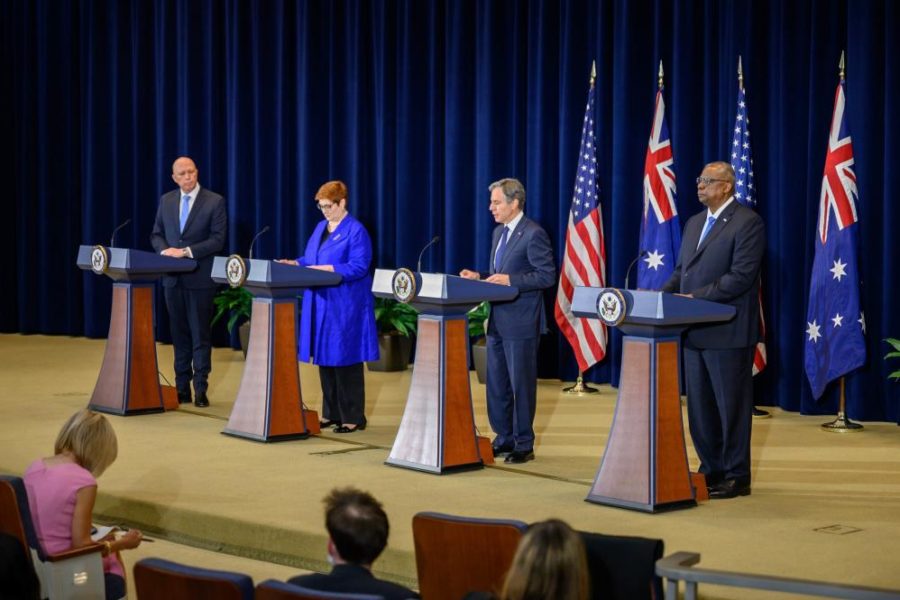Defense Secretary Lloyd J. Austin III revealed Sept. 16 further air defense cooperation measures with Australia and that more U.S. troops will be heading there, going beyond President Joe Biden’s announcement a day earlier that the United States and United Kingdom will share nuclear submarine technology with the Pacific ally in the face of a growing threat from China.
Speaking alongside Secretary of State Antony J. Blinken and their Australian counterparts at the State Department, Austin said the U.S. and Australia will increase exercises, training, and sharing of defense technology.
“We will continue to explore … greater and more frequent engagement and air capabilities,” Austin said. “More training opportunities for our ground forces and increasing our logistical footprint in Australia as well.”
In his first hint at what the now overdue force posture review may reveal, the Secretary indicated Australia will receive more U.S. troops.
“Today, we endorsed major force posture initiatives that will expand our access and presence in Australia,” Austin said in his opening statement, noting further force integration and interoperability would be part of that effort.
Australian Defense Minister Peter Dutton said that would mean more basing for American troops.
“I do have an aspiration to make sure that we can increase the numbers of troops. Through the rotations, the air capability will be enhanced, our maritime capability enhanced, and certainly the force posture enhanced,” Dutton said. “And if that includes basing and includes the storage of different ordnances, I think that is in Australia’s best interest.”
The Australians said the air cooperation agreement would span all platforms, with Dutton pointing to the multinational Talisman Sabre exercise with the U.S. in July.
In August 2020, B-1s operating from Andersen Air Force Base in Guam and B-2s from Naval Support Facility Diego Garcia participated in a training exercise, dropping training bombs at three Australian training locations. In November, the U.S. and Australia formalized an agreement to cooperate on the development of long-range prototype hypersonic weapons. Austin did not respond to specific questions about the bombers or hypersonic weapons cooperation.
Dutton also said Australia and the U.S. reached a “space framework agreement” to increase his country’s space knowledge and capabilities, but Austin declined to elaborate.
A China Heavy Meeting
The annual “2+2” meeting, held in Washington, D.C., this year due to tight COVID restrictions in Australia, focused heavily on security in the Indo-Pacific region.
Australia and China are in a detente stretching 12 months since Australian comments that the origin of the new coronavirus needs further investigation. China slapped back with export restrictions on Australian agriculture and wine.
China also reacted swiftly to the deal for sharing nuclear submarine technology, calling the move an arms race and promising retaliation.
Australian China-watchers predict further Chinese cyberattacks on Australia but admit the relationship is already at a low with no high-level dialogue occurring between the two nations.
Blinken sought to assure that the United States will not leave Australia alone “on the pitch.”
“The United States will not leave Australia alone,” the Secretary of State said. “We’ve raised publicly and privately our serious concerns about Beijing’s use of economic coercion against Australia.”
Meanwhile, Australia and the United States are now faced with a resulting deterioration in their relationships with France, which loses a major submarine agreement with Australia. The French minister of defense did not respond to an Air Force Magazine request for comment. France moved to demonstrate its displeasure, reportedly canceling a celebration of the U.S. defense partnership scheduled for its embassy in Washington.
Austin also downplayed rising tensions with China in a response to a question from Air Force Magazine.
“On the issue of China, let me just emphasize upfront that this agreement, this relationship, is not aimed at anything or anyone,” he said. “The intent here is to help improve our trilateral cooperation and our capabilities across the board.”
The Australian defense minister was less coy, saying it was indeed about China.
“This is not the first time that we’ve seen different outbursts from China in terms of Australia’s position,” Dutton said in response to the same question.
“It’s formed the basis of much of our discussion here with our colleagues—very significant uncertainty, and more so than any time since the Second World War,” he added later. “We do believe it’s in Australia’s national security interests to deepen our relationship with the United States.”
Under the new trilateral security agreement, dubbed “AUKUS” for Australia, U.K., and U.S., officials will spend the first 18 months determining a path forward for sharing nuclear submarine technology to build a fleet of Australian nuclear-powered submarines. Dutton said the current Royal Australian Navy fleet of conventional diesel submarines will undergo a life extension in 2026 that will take it to the 2040s.
The capabilities that nuclear-powered submarines could deliver to Australia will greatly increase Australia’s reach and help Australia safeguard the Pacific, Dutton said.
AUKUS will also include defense cooperation in areas of artificial intelligence, quantum computing, cybersecurity, and additional undersea capabilities.

